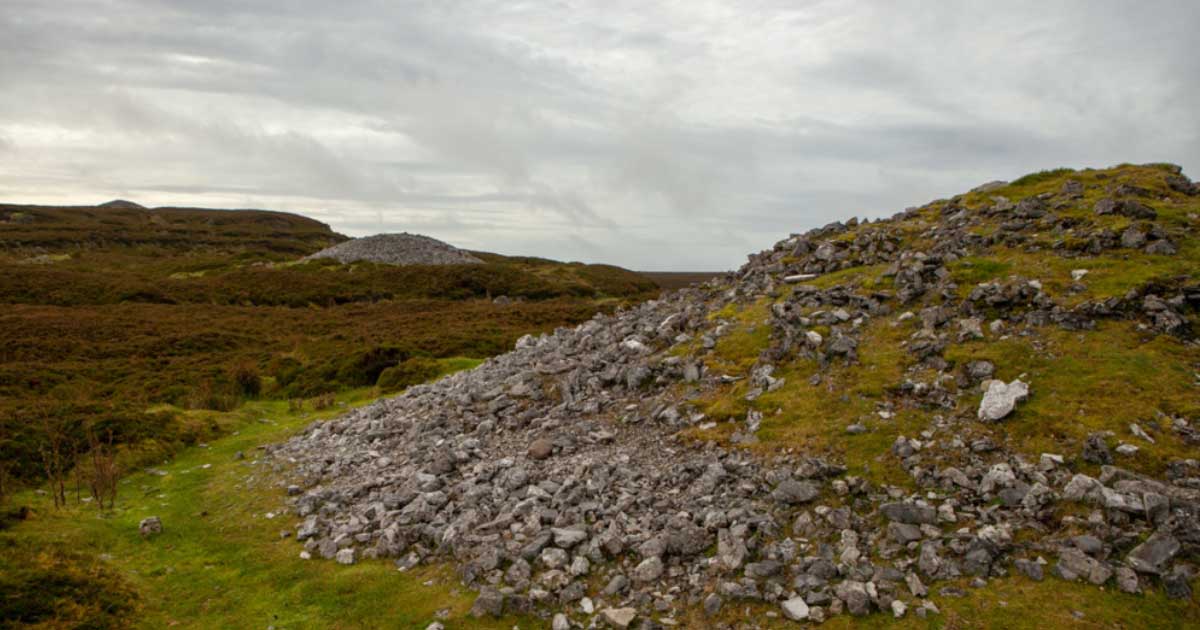Carrowkeel Megalithic Cemetery: Passage Tombs and An Astronomical Roofbox
Carrowkeel Megalithic Cemetery is a passage tomb complex dating to the Neolithic period. This cemetery is located in the south of County Sligo, in the western Irish province of Connacht. In Carrowkeel Megalithic Cemetery, 14 or 15 passage tombs have been identified, the best preserved of which being Cairn G.
Carrowkeel (which means’ the Narrow Quarter’) is situated in the Bricklieve (meaning ‘Speckled Hills’) Mountains. It lies on the west side of Lough Arrow (a freshwater lake), overlooking the modern village of Castlebaldwin. Carrowkeel Megalithic Cemetery lies on the ‘line’ of passage tombs stretching from County Sligo in the west to County Meath in the east. This ‘line’ was created as Neolithic burial practices spread eastwards on the island. Carrowkeel is one of the four largest passage tomb complexes in Ireland, the other three being Carrowmore (also in County Sligo), Loughcrew, and Brú no Bóinne (both of which are located in County Meath).

Carrowkeel Megalithic Cemetery. Credit: Ioannis Syrigos
The first excavation of Carrowkeel Megalithic Cemetery took place in 1911, and was undertaken by R.A.S. Macalister. Over a period of 15 working days divided between three visits, Macalister and his two colleagues, Armstrong and Praeger, managed to completely excavate eight tombs. The primary goal of their fieldwork was to find valuable artifacts. The speed with which the excavations were carried out meant that the work was conducted in a reckless manner. As a consequence, much valuable archaeological information (especially so considering that the tombs have been left intact) was destroyed during Macalister’s fieldwork. Although Macalister dated the tombs to the Bronze Age, later research showed that they were created during the Neolithic, though continued to be used during the Bronze Age.

A view inside one of the cairns. Credit: Ioannis Syrigos
The first passage tomb excavated by Macalister was Cairn G. This is also the first structure modern visitors would see as they enter the site from the car park. Cairn G is the best preserved passage tomb at the site. The main chamber measures 21 m (69 feet) in diameter, and is entered via a short passageway. The main chamber is attached to three side chambers, resulting in a cruciform. When Macalister entered this chamber in 1911, its floor was paved with limestone flags, though these are today under a layer of loose cairn stones. The walls of the chamber are formed by eight large orthostats, and the archaeological finds within the tomb include burnt bones, pottery fragments, pendants, and beads.
The most intriguing feature of Cairn G, however, is a structure above its entrance known as a roofbox. In Ireland, the only other known example of a roofbox is found in Newgrange. A third example of a roofbox was discovered in recent years, in Crantit on the Orkney Islands. It has been suggested that the roofbox of Cairn G served an astronomical function, as it was found to be aligned with the setting of the Sun during midsummer. Each year, for a month prior to and after midsummer, the rays of the setting Sun are able to reach into the chamber of Cairn G from the roofbox.
- Creevykeel Court Tomb: Giants and Little People Meet at a 4,500 Year Old Irish Tomb
- Carrowmore Megalithic Cemetery: Where Prehistoric Ireland went for Ritual Burials in a Big Way
- Mystifying Megaliths: Knowth, Keeper of Ancient Tombs
Close to Cairn G are Cairns H, K, and L. As these four passage tombs are the ones located closest to the car park, they are also the most visited (due to their accessibility). It may be mentioned, however, that none of these four were likely to have been the most important monument of the site. It has been speculated that Cairn F, located to the southwest of the four tombs, may have been the site’s most significant tomb. For a start, this is the largest tomb at the site. Additionally, this is the only tomb (along with the nearby Cairn E) that is visible from both north and south. Moreover, a non-structural standing stone was found to have been placed in a prominent position in the burial chamber. It has been speculated that the stone may have served as a symbol of fertility.
Top image: Carrowkeel Megalithic Cemetery. Credit: Ioannis Syrigos
By Wu Mingren
References
Dempsey, J., 2018. Carrowkeel Complex. [Online]
Available at: http://www.megalithicireland.com/Carrowkeel%20home.htm
Goldbaum, H., 2018. Carrowkeel Passage Tombs. [Online]
Available at: https://voicesfromthedawn.com/carrowkeel/
Irish Tourism, 2018. Carrowmore Megalithic Cemetery. [Online]
Available at: https://www.irishtourism.com/historic-sites-buildings-in-ireland/carrowmore-megalithic-cemetery/1456
Lonely Planet, 2018. Carrowkeel Megalithic Cemetery. [Online]
Available at: https://www.lonelyplanet.com/ireland/attractions/carrowkeel-megalithic-cemetery/a/poi-sig/1572517/359581
Sacred Island Guided Tours, 2018. Cairn G. [Online]
Available at: http://www.carrowkeel.com/sites/carrowkeel/cairng1.html
Sacred Island Guided Tours, 2018. Cairn G: astronomical observations. [Online]
Available at: http://www.carrowkeel.com/sites/carrowkeel/cairng2.html
Sacred Island Guided Tours, 2018. The Carrowkeel megalithic complex. [Online]
Available at: http://www.carrowkeel.com/sites/carrowkeel/index.html

















